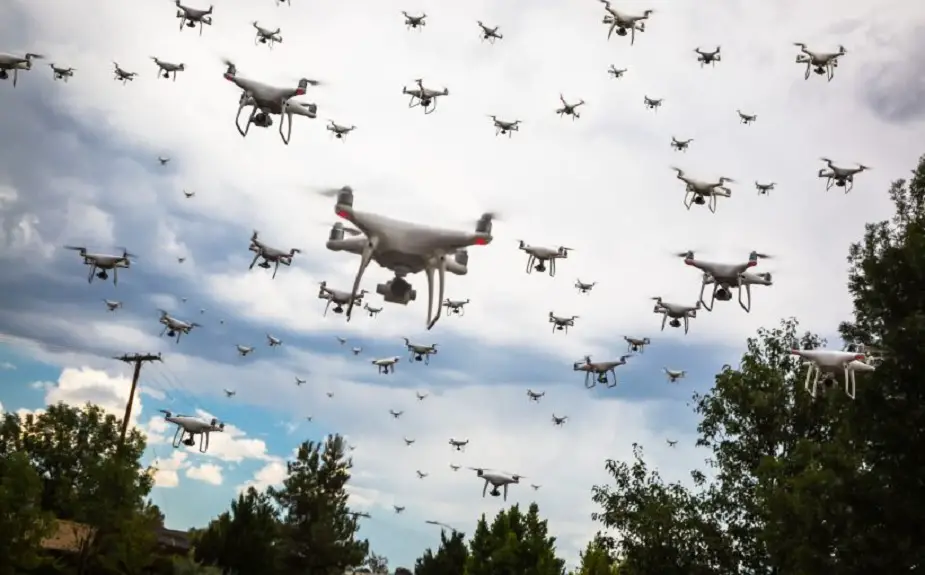DARPA’s OFFensive Swarm-Enabled Tactics (OFFSET) program
DARPA’s OFFensive Swarm-Enabled Tactics (OFFSET) program envisions future small-unit infantry forces using swarms comprising upwards of 250 unmanned aircraft systems (UASs) and/or unmanned ground systems (UGSs) to accomplish diverse missions in complex urban environments. By leveraging and combining emerging technologies in swarm autonomy and human-swarm teaming, the program seeks to enable rapid development and deployment of breakthrough capabilities.
 OFFSET aims to provide the tools to quickly generate swarm tactics, evaluate those swarm tactics for effectiveness, and integrate the best swarm tactics into field operations (Picture source: Andy Dean)
OFFSET aims to provide the tools to quickly generate swarm tactics, evaluate those swarm tactics for effectiveness, and integrate the best swarm tactics into field operations (Picture source: Andy Dean)
OFFSET aims to provide the tools to quickly generate swarm tactics, evaluate those swarm tactics for effectiveness, and integrate the best swarm tactics into field operations. To accomplish these goals, OFFSET will develop an active swarm tactics development ecosystem and supporting open systems architecture, including:
An advanced human-swarm interface to enable users to monitor and direct potentially hundreds of unmanned platforms simultaneously in real time. The program intends to leverage rapidly emerging immersive and intuitive interactive technologies (e.g., augmented and virtual reality, voice-, gesture-, and touch-based) to create a novel command interface with immersive situational awareness and decision presentation capabilities. The interface would also incorporate a swarm interaction grammar, enabling “freestyle” design of swarm tactics that allow dynamic action and reaction based on real-time conditions in the field.
A real-time, networked virtual environment that would support a physics-based, swarm tactics game. In the game, players would use the interface to rapidly explore, evolve, and evaluate swarm tactics to see which would potentially work best, whether using various unmanned systems in the real world or exploring innovative synthetic technologies in the virtual one. Users could submit swarm tactics and track their performance from test rounds on a leaderboard, to encourage both competition and collaboration.
A community-driven swarm tactics exchange. This curated, limited access program portal would house tools to help participants design swarm tactics by composing collective behaviors, swarm algorithms, and even other existing tactics. It would provide these key ingredients to an extensible architecture for end-user-generated swarm tactics and help create a lasting community to innovate and cultivate the most effective tactics, with the potential to integrate third-party tactics and future users.
OFFSET is structured to demonstrate its technologies through frequent live experiments with various unmanned air and ground platforms. Roughly every six months, operational vignettes of progressively increasing complexity would challenge both the swarm architecture and the developed swarm tactics across numerous technological and operational test variables, such as swarm size, spatial scale of operations, and mission duration. Users would employ the swarm interface to test the best of the virtual tactics in the real world, and interactively supply their unmanned platforms with near-real-time tactics updates using automated deployment technologies.
During the second field experiment for DARPA’s OFFensive Swarm-Enabled Tactics (OFFSET) program, on June 2019, teams of autonomous air and ground robots tested tactics on a mission to isolate an urban objective. Similar to the way a firefighting crew establishes a boundary around a burning building, they first identified locations of interest and then created a perimeter around the focal point.
For the experiment, which took place in June at the Selby Combined Arms Collective Training Facility in Fort Benning, Georgia, teams undertook a complex scenario spanning two city blocks. Tasks included locating and isolating a mock city hall building, locating and securing an objective inside, and then securing the building – all while maintaining situational awareness of the surrounding area. Runs lasted up to 30 minutes each.
OFFSET includes two main performer types: Swarm System Integrators and Swarm Sprinters. The Swarm System Integrators, Northrop Grumman and Raytheon BBN, create OFFSET architectures, interfaces, and their respective Swarm Tactics Exchanges, which houses tools to help performers design swarm tactics by composing collective behaviors, swarm algorithms, and existing swarm tactics. The Swarm Sprinters perform focused tasks and deliver additional technologies to merge with system integrators.
The June event brought together the integrators and second set of Swarm Sprinters, including Heron; Michigan Tech Research Institute; University of North Carolina, Charlotte; and Cornell University, to integrate and test swarm autonomy tactics and technologies.
“The pace of our scheduled experiments requires our performers to take risks” said Timothy Chung, the OFFSET program manager in DARPA’s Tactical Technology Office. “Rapid integration demands that our swarm teams, both integrators and sprinters, develop smarter ways to improve their current processes.”
The experiment at Fort Benning highlighted the benefits of continuous agile development and integration and deployment, the principle at the heart of the OFFSET program. The Swarm System Integrators showed maturation in field operations while the Swarm Sprinters contributed technologies to enhance system performance. The platform experimentation provided insights into the role of commercial-off-the-shelf technologies in a research and development program.
The recent field experiment was the second of six scheduled tests. Additional field experiments are targeted at intervals about six-months apart.
DARPA has awarded contracts for the next Swarm Sprint to develop novel approaches to Human-Swarm Teaming over the next six months to demonstrate in the next OFFSET field experiment. The awardees are Case Western Reserve University, Charles River Analytics, Inc. and Northwestern University
Each of the planned five core “sprints” focuses on one of the key thrust areas: Swarm Tactics, Swarm Autonomy, Human-Swarm Teaming, Virtual Environment, and Physical Testbed. Each Swarm Sprint topic emphasizes different perspectives to ultimately enable breakthroughs in swarm capabilities.


























